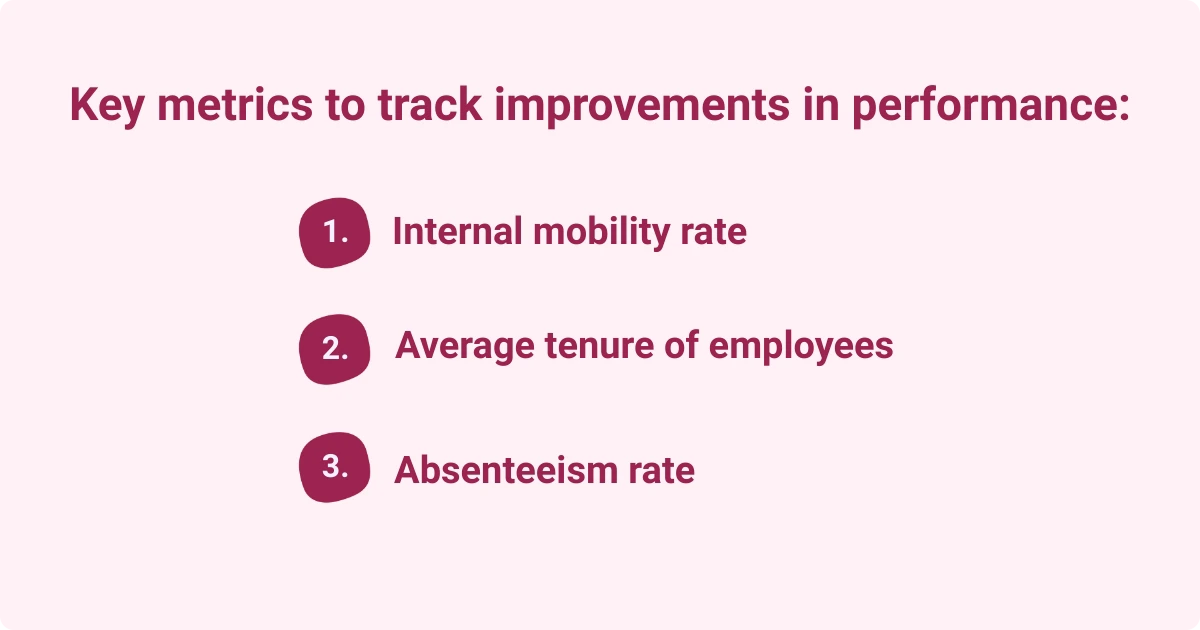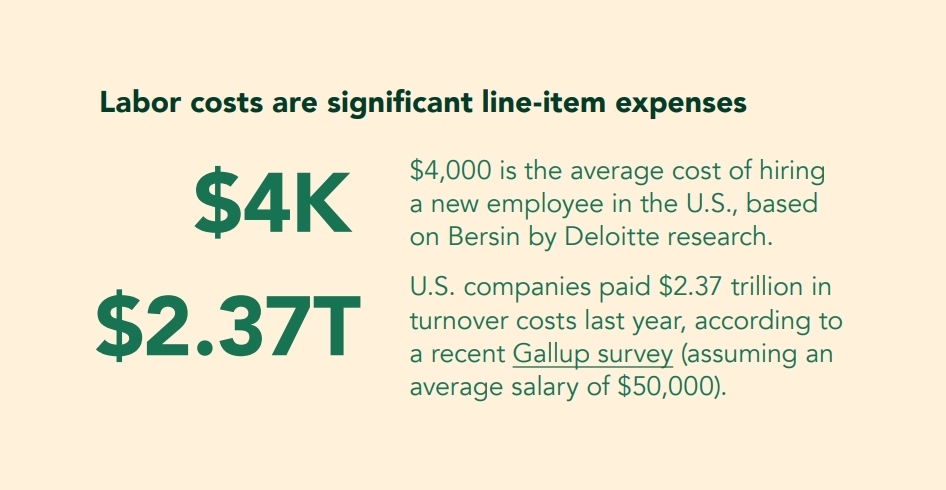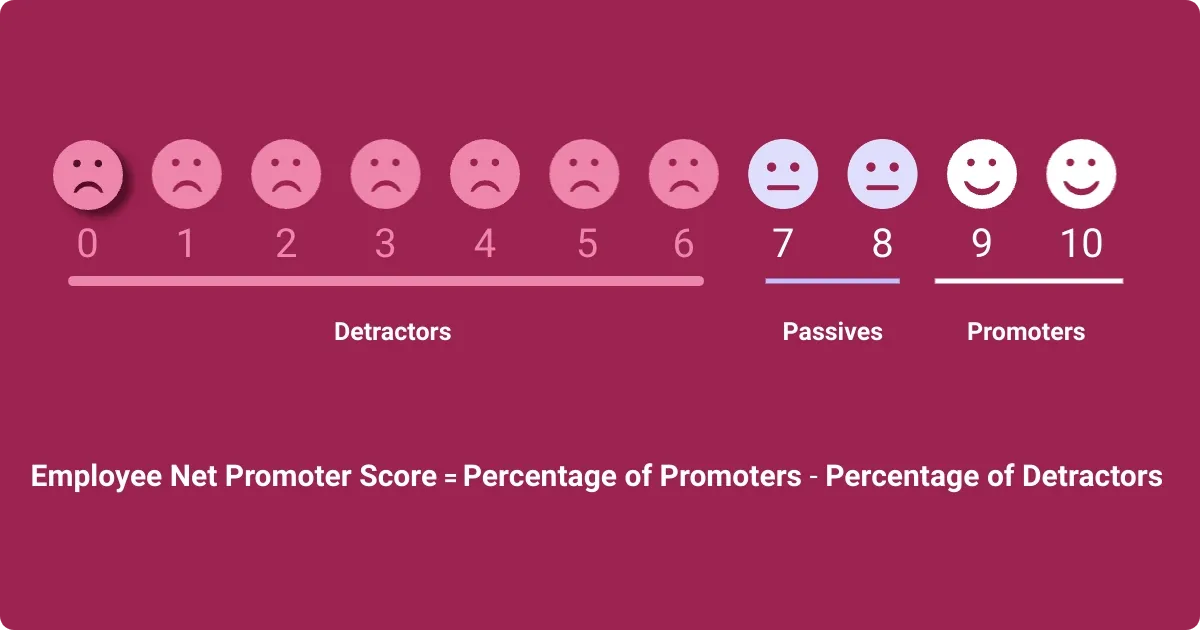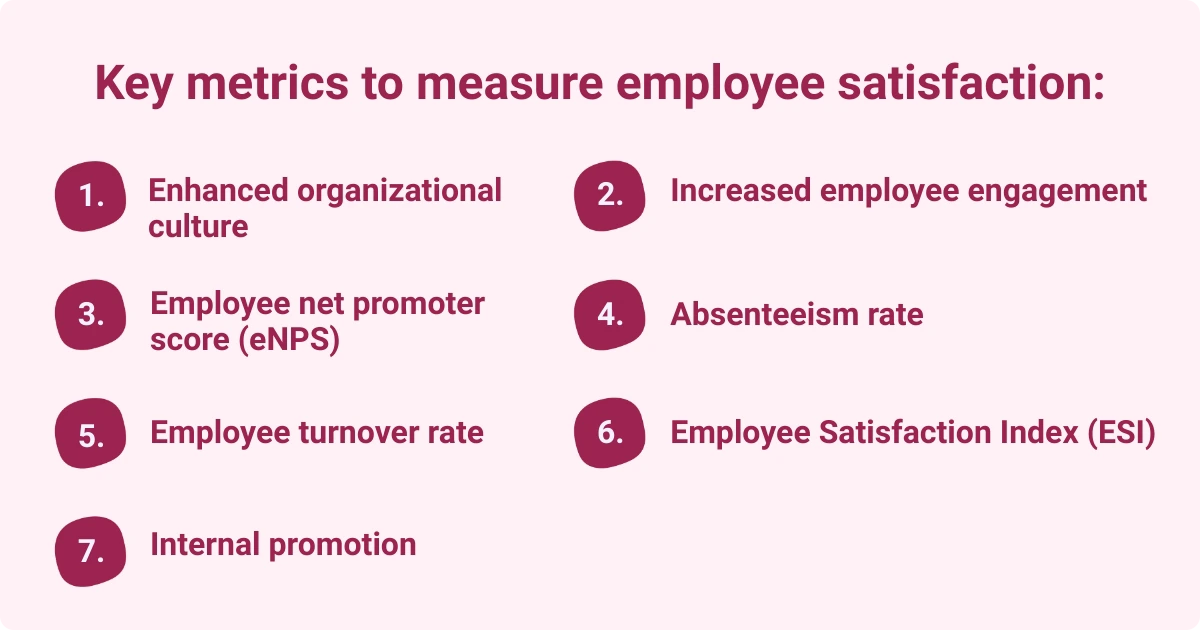How to Measure Employee Satisfaction: Metrics and Methods That Work
Table of contents
- What is employee satisfaction?
- Why companies should measure employee satisfaction
- Key metrics to measure employee satisfaction
- Methods for collecting and analyzing employee satisfaction data
- Steps for an effective employee satisfaction measurement strategy
- Boost employee satisfaction to make your company strong

Low engagement led to a loss of $8.9 trillion in global GDP in 2023, according to Gallup research on the state of the global workplaceOpens in a new tab. Employees who are unsatisfied with their jobs tend to invest less in their work and even miss more work days.
Knowing how to measure employee satisfaction is the first step to improving the employee experience at your company. By prioritizing worker satisfaction, you can reduce churn, lower absenteeism, and increase productivity.
What is employee satisfaction?
Employee satisfaction reflects your employees' contentment with their jobs. It shows how happy they are both in their roles and with the company. This encompasses a variety of factors, including:
- Work-life balance
- Job security
- Compensation and benefits
- Career development opportunities
- Recognition and appreciation
- Positive work environment
- Effective leadership
- Autonomy
- Good interwork relationships
- Alignment with company values
A study published in Frontiers in Business and Economics titled "The Relationship between Employee Satisfaction and Employee Performance mediated by Employee Engagement" notes that satisfaction has a strong impact on employee engagement and performance because more satisfied employees have a deeper interest in their company performing well.
Why companies should measure employee satisfaction
Measuring employee satisfaction not only helps you understand how workers feel about their jobs but also gives you an indication of your company's performance. Satisfied employees are likely to invest more in their work, leading to better output.
Improved performance and productivity
Employees who feel satisfied with their jobs have a higher sense of dedication to the company, which motivates them to work harder and make a difference. They understand that what they get out of their job also meets their own goals, making them happy to work hard.
In turn, this means lower absenteeism, as indicated by a study in the Journal of Informatics Education and Research on the effectiveness of employee wellness programsOpens in a new tab.
To track improvements in performance based on satisfaction, pay attention to metrics such as:
- Internal mobility rate: Look at the number of employee promotions or transfers within the organization to understand their career opportunities and improved performance.
- Average tenure: If employees stay at your company for a longer time on average, your company has better stability and loyalty, leading to more institutional knowledge and team cohesion and raising productivity.
- Absenteeism rate: When employees voluntarily miss fewer days, you get more working hours per year, raising your company's productivity.

Reduced turnover and associated costs
Employees who are satisfied with their jobs are less likely to seek employment elsewhere, resulting in significant long-term savings.
Lower turnover reduces recruitment expenses, which, according to research by Bersin by Deloitte, cost U.S. companies approximately $4,000 per new hire. Additionally, it eliminates the need to spend on onboarding and training new employees—a process that cost American companies $101.8 billion in 2022-2023, as noted in the Training Industry ReportOpens in a new tab.

To retain employees and show them that their skills genuinely contribute to the company’s success, consider actions like:
- Regularly acknowledging their accomplishments
- Providing timely and meaningful raises
- Offering benefits that address their needs, such as:
- Employee development programs for younger workers
- Flexible work arrangements for those with young children
Key metrics to measure employee satisfaction
The next question is how to measure job satisfaction. Being a qualitative concept, it's more difficult to track than something like net spend. However, looking at certain key performance indicators (KPIs) of employee satisfaction gives a strong indication of your employees' overall satisfaction levels.
Enhanced organizational culture and reputation
Because increased job satisfaction leads to less turnover, employees have time to build strong bonds with each other, creating a connected workforce.
Satisfied employees have better morale, stronger communication, and a stronger sense of loyalty to the company because they see it as a collection of all the people they have relationships with rather than just an organization that pays them. As a result, the company culture becomes more positive.
This leads to more employee advocacy for your company as well as more positive ratings on websites like Glassdoor. Employees and job seekers will see that your organization has a positive work environment that offers opportunities for growth and demonstrates financial stability.
When your company reflects these qualities, you're more likely to attract high-quality candidates deciding between different companies, further helping your organization to thrive.
Increased employee engagement
A recent study on the relationship between job satisfaction and employee engagementOpens in a new tab in Indonesia published in Edelweiss Applied Science and Technology noted that employee engagement positively affects job satisfaction even more than competence.
It's important to make sure employees feel committed and connected to their work. When they are invested in the company's goals, then they feel more satisfied with the work they're doing.
A higher employee engagement in the workplace drives greater commitment to your company's goals and mission, as it indicates that employees' goals align closely with the company's.
A simple way to boost engagement scores is to encourage peer-to-peer recognition. Workhuman® research found that employees who receive frequent recognition and congratulations from their co-workers see performance ratings rise year over year.
Employee net promoter score (eNPS)
The employee net promoter score (eNPS) is one of the most popular employee satisfaction metrics that human resources teams collect.
To measure it, send out a survey that asks things like "On a scale from 1 to 10, how likely are you to recommend this organization as a place to work?" or “Based on your experience here, how likely would you be to recommend our organization to a friend or colleague?”
Divide the responses into three buckets:
- Promoters: 9s or 10s indicate employees are satisfied and happy to advocate for your company freely.
- Passives: 7s or 8s indicate employees are feeling neutral — while they won’t recommend the company to a friend, they also won’t speak negatively about it.
- Detractors: Employees who rate the company at a six or below are unsatisfied with the company.
Your eNPS score is the percent of promoters subtracted by the percent of detractors. Scores can range from -100 to +100, and you want a positive score, meaning you have more promoters than detractors.

Absenteeism rate and its significance
Absenteeism in the workplace could indicate many different issues, including:
- Poor working conditions
- Poor governance
- Poor leadership
- Lack of work-life balance
It also reflects your employee satisfaction, as less satisfied employees are more likely to take time off when possible to avoid working.
There is also a knock-on effect to absenteeism because the employees who are present have to cover for the workload of the absent employees. In turn, these employees also get more stressed and end up with more job dissatisfaction as well, making absenteeism a problem that must be addressed urgently.
Employee turnover rate as a key indicator
There is an inverse relationship between job satisfaction and turnover intention. The more satisfied an employee is — meaning they feel supported, have good work relationships, feel appropriately challenged, and are receiving development — the less likely they are to resign.
The cost of acquiring and onboarding new employees, along with the time lost in the hiring process — which a 2024 Pinpoint HQ study on the average time to hire gives as 31 days — makes turnover rate a key metric to track.
To take a more proactive look at your turnover rate, you can also use predictive analysis to predict turnover risk. With these results, you can actively make changes to reduce your risk before your employees leave.
Employee Satisfaction Index (ESI)
ESI measures your employees' job satisfaction with three basic questions:
- How satisfied are you with your workplace?
- How well does your workplace meet your expectations?
- How close is your workplace to your ideal job?
Employees give answers on a scale from 1 to 10. So, what is a good employee satisfaction score? To calculate your ESI, average all the responses and multiply your result by 100. The higher this number, the better your employee satisfaction ratings.
Because you need to send these questions out in a survey anyway, you can embed them in a larger survey that asks for more qualitative, open-ended responses as well to learn about pain points employees are facing. For example, your survey could ask:
- How well does your workplace meet your expectations?
- Do you feel you are provided with all the tools and enough training to do your job effectively?
- Do you believe you are growing in your career every day?
- How satisfied are you with your workplace?
- Do you understand what is required of you in your job?
- Are you satisfied with the opportunities for development?
- Do you have a reasonable amount of work that is manageable?
- How close is your workplace to being your ideal job?
You could also ask open-ended questions like:
- What can we do differently as an organization to make you happy?
- What do you like about your job?
- What do you not like about your job?
- What would make you look for another job at another company?
- How could we make work more meaningful for you?
Internal promotion as a measure of satisfaction
A high internal promotion rate in a company indicates that its employee base is receiving development experience, helping employees reach their longer-term career goals. This KPI also shows when employees are satisfied enough with the company to remain at it for the multiple years necessary to move up to higher positions rather than looking externally for new opportunities.

Methods for collecting and analyzing employee satisfaction data
Absenteeism rates and internal promotion rates are trackable metrics that your human resources team will have access to. However, these alone don't tell you the full story of your employee satisfaction. You need to look at both qualitative and quantitative data to understand how your employee base feels about your company and where you can improve.
Gathering feedback through employee surveys
Surveys are powerful employee satisfaction measurement tools. Send them out at regular intervals for continuous feedback. This helps you identify and address issues in real-time rather than waiting to find out your absenteeism rate or turnover for a quarter.
There are a variety of survey types that you can circulate to gauge and improve employee satisfaction, depending on what areas you want to focus on. For example:
- Employee satisfaction surveys: These ask employees how they feel about their ability to get work done, the communication and instructions they receive, the distribution of workload, the company culture and mission, other team members, and their opportunities for advancement.
- Employee experience surveys: These ask for qualitative, open-ended responses on how employees feel about their time working at the company, helping you identify ways to improve their lives at work.
- Employee engagement surveys: These gauge employee sentiment and engagement levels, identifying strengths and areas for improvement in employee roles, work environment, and the company culture.
- Pulse surveys: These are a short, regular series of questions you send to employees to measure and track employee sentiment, such as asking how motivated an employee feels at work or if they found a recent training session helpful or impactful.
Survey responses are also the basis for satisfaction metrics such as your eNPS and your ESI.
Exit interviews for deeper insights
Exit interviews are a great way to learn what led to employees feeling dissatisfied enough with your company to leave or seek work elsewhere. Sometimes the response will simply be that they received a higher-paying offer, but employees who are leaving are typically more candid if they had concerns while working at the company.
This data reveals issues that current employees may not be open to discussing, giving you valuable insight. You can also learn more about what your competitor companies offer, helping you understand how you need to improve your offerings to remain attractive to high-quality candidates.
One-on-one meetings for personalized insights
One-on-one meetings where employees can freely speak their minds about the company without fear of repercussion build trust with the employee base and foster open communication channels that are very helpful in the long run. Employees who feel more comfortable discussing their frustration points with upper management will be more open to providing honest feedback about their satisfaction.
These discussions also give workers the opportunity to better understand the company's goals and how it is achieving them. As a result, employees can align more closely with the company values and better understand the actions that the company takes.
Benchmarking employee satisfaction for comparative analysis
Websites like Glassdoor.com provide public data on employee satisfaction, reported by employees themselves. As well as looking up this information for your own company, you can get even more value out of these websites by also researching the data published for your competitors in your industry.
With a wider view of satisfaction data in your field, you can understand how your company fares in comparison to a benchmark and identify areas for improvement.
Steps for an effective employee satisfaction measurement strategy
Measuring employee satisfaction one time or at random intervals gets you some data but not necessarily the most actionable information. Follow a clear strategy to effectively measure your employee satisfaction and track improvements.
1. Define clear objectives and metrics
Identify what you want to achieve through measuring employee satisfaction. This helps you figure out which employee satisfaction KPIs you want to track. For example, you may want to reduce the turnover rate or attract more high-quality candidates.
2. Select appropriate measurement methods
Based on your goal and the metrics you need to track for progress, establish what measurement methods make sense. For example:
- Exit surveys are a powerful tool to reduce turnover rates.
- Pulse checks show you how employees feel on a more frequent basis, helping you more quickly understand what might be causing absenteeism and lower satisfaction.
- Feedback platforms are a good source of information for attracting better candidates.
Also, think about the ideal survey cadence for your goals. Do you want responses on a weekly basis, bi-weekly, monthly, or after certain events like training or meetings?
3. Design surveys carefully with targeted questions
The next step is to carefully select the questions for your employee satisfaction survey to ensure you receive valuable responses aligned with your goals. Avoid a common survey pitfall: mistaking correlation for causation. Whenever possible, craft specific questions that not only explore what employees are doing and feeling but also uncover the reasons behind their actions and emotions.
You might ask employees general questions, such as whether they are satisfied with their jobs or how likely they are to look for new employment. However, a more specific question like, "If you are likely to seek other employment, what aspects of your current job are driving that decision?" provides deeper, actionable insights into the changes you need to implement.

4. Analyze data to identify trends and areas for improvement
After distributing the survey and collecting responses, compile and analyze the data to uncover common trends. These trends will highlight both your strengths and areas that need improvement. Utilize analytics tools to visualize the data and quickly pinpoint actionable insights.
5. Take action based on the insights gathered
Use your findings to implement changes that improve your organization. This step is crucial—when employees see that their feedback is being heard and that you’re actively addressing their concerns, they’ll feel more motivated to engage with future surveys and provide even more valuable insights over time.
Have a meeting with your leadership team to discuss employee feedback and figure out immediate steps to take toward addressing it. When you implement changes, communicate them clearly to your organization, explaining what the feedback was and how the changes you've made aim to improve the work environment.
Boost employee satisfaction to make your company strong
Knowing how to measure employee satisfaction gives you a strong competitive edge, but you need to also act on the data you gather to get results. Once you have a strategy in place that you regularly evaluate to improve, you can develop a more satisfied worker base.
This, in turn, helps you improve company culture, reduce absenteeism, and ultimately drive profits. Prioritizing the satisfaction of your employees strengthens your company.